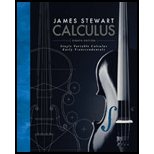
Single Variable Calculus: Early Transcendentals
8th Edition
ISBN: 9781305270336
Author: James Stewart
Publisher: Cengage Learning
expand_more
expand_more
format_list_bulleted
Concept explainers
Question
Chapter E, Problem 39E
To determine
To prove: The formula
Expert Solution & Answer
Trending nowThis is a popular solution!

Students have asked these similar questions
Use the circle to find exact value of each trigonometric function (number 16)
Use the circle to find exact value of each trigonometric function (number 22)
Use the circle to find exact value of each trigonometric function (number 20)
Chapter E Solutions
Single Variable Calculus: Early Transcendentals
Ch. E - Prob. 1ECh. E - Write the sum in expanded form. 2. i=161i+1Ch. E - Prob. 3ECh. E - Write the sum in expanded form. 4. i=46i3Ch. E - Prob. 5ECh. E - Prob. 6ECh. E - Prob. 7ECh. E - Prob. 8ECh. E - Write the sum in expanded form. 9. j=0n1(1)jCh. E - Write the sum in expanded form. 10. i=1nf(xi)xi
Ch. E - Prob. 11ECh. E - Write the sum in sigma notation. 12. 3+4+5+6+7Ch. E - Prob. 13ECh. E - Write the sum in sigma notation. 14....Ch. E - Prob. 15ECh. E - Prob. 16ECh. E - Prob. 17ECh. E - Prob. 18ECh. E - Prob. 19ECh. E - Prob. 20ECh. E - Prob. 21ECh. E - Prob. 22ECh. E - Prob. 23ECh. E - Prob. 24ECh. E - Prob. 25ECh. E - Find the value of the sum. 26. i=11004Ch. E - Prob. 27ECh. E - Prob. 28ECh. E - Prob. 29ECh. E - Prob. 30ECh. E - Find the value of the sum. 31. i=1n(i2+3i+4)Ch. E - Prob. 32ECh. E - Prob. 33ECh. E - Prob. 34ECh. E - Prob. 35ECh. E - Prob. 36ECh. E - Prob. 37ECh. E - Prob. 38ECh. E - Prob. 39ECh. E - Prove formula (e) of Theorem 3 using the following...Ch. E - Evaluate each telescoping sum. (a) i=1n[i4(i1)4]...Ch. E - Prob. 42ECh. E - Prob. 43ECh. E - Prob. 44ECh. E - Prob. 45ECh. E - Prob. 46ECh. E - Prob. 47ECh. E - Prob. 48ECh. E - Prob. 49ECh. E - Prob. 50E
Knowledge Booster
Learn more about
Need a deep-dive on the concept behind this application? Look no further. Learn more about this topic, calculus and related others by exploring similar questions and additional content below.Similar questions
- Write an equation for the function graphed below. The y intercept is at (0,-0.2) 5+ 4 -7 -6 -5 -4 -3 3. -2- 2 1 + 1 2 3 5 6 7 -1 2 -4 3 4 5 -5arrow_forwardUse the circle to find exact value of each trigonometric function (number 18)arrow_forwardWrite an equation for the function graphed below 5+ 4 3 2 1 -7 -6 -5 3 4 5 6 -1 y = 3 4 5 -3 -4 la -5+arrow_forward
arrow_back_ios
SEE MORE QUESTIONS
arrow_forward_ios
Recommended textbooks for you
- Algebra & Trigonometry with Analytic GeometryAlgebraISBN:9781133382119Author:SwokowskiPublisher:Cengage

Algebra & Trigonometry with Analytic Geometry
Algebra
ISBN:9781133382119
Author:Swokowski
Publisher:Cengage
01 - What Is A Differential Equation in Calculus? Learn to Solve Ordinary Differential Equations.; Author: Math and Science;https://www.youtube.com/watch?v=K80YEHQpx9g;License: Standard YouTube License, CC-BY
Higher Order Differential Equation with constant coefficient (GATE) (Part 1) l GATE 2018; Author: GATE Lectures by Dishank;https://www.youtube.com/watch?v=ODxP7BbqAjA;License: Standard YouTube License, CC-BY
Solution of Differential Equations and Initial Value Problems; Author: Jefril Amboy;https://www.youtube.com/watch?v=Q68sk7XS-dc;License: Standard YouTube License, CC-BY